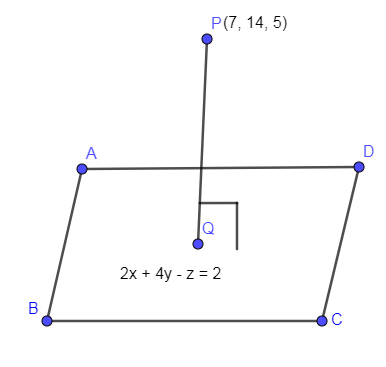Question
Question: Find the length and foot of the perpendicular from the point \(P\left( 7,14,5 \right)\) to the plane...
Find the length and foot of the perpendicular from the point P(7,14,5) to the plane 2x+4y−z=2.
Solution
Let us assume that the foot of the perpendicular on the plane is Q(x1,y1,z1). Now, write the vector PQ. Then write the vector normal to the given plane 2x+4y−z=2. The vector normal to this plane is 2i∧+4j∧−k∧and let name this vector as n. Now, the vector PQ is parallel to this vector n so apply the condition of two parallel vectors and then you get the value of x1,y1,z1 in terms of some constant. Then to eliminate that constant satisfy the point Q in the equation of a plane 2x+4y−z=2. Hence, you will get the point Q which is perpendicular. Now, to find the length of the perpendicular from point P to the plane find the distance between the point P and Q using distance formula.
Complete step by step answer:
We have given a plane with the following equation:
2x+4y−z=2
And we are asked to find the length and foot of the perpendicular from the point P(7,14,5) to the plane.
Let us assume that the foot of the perpendicular from point P(7,14,5) is Q(x1,y1,z1). In the below diagram, we have shown a plane 2x+4y−z=2 and points P and Q.

Now, the normal vector corresponding to the given plane 2x+4y−z=2 is given as:
2i∧+4j∧−k∧
And we are denoting the vector by n so rewriting the above expression as:
n=2i∧+4j∧−k∧
Now, find the vector PQ by subtracting x, y and z coordinate of point P from x, y and z coordinate of Q and multiplying the x coordinate, y coordinate and z coordinate difference by i∧,j∧,k∧ respectively.
PQ=(x1−7)i∧+(y1−14)j∧+(z1−5)k∧
Now, normal vector n and the above vector PQ is parallel so their x, y and z coordinates are proportional.
2(x1−7)=4(y1−14)=−1(z1−5)=λ
Now, equating each fraction to λ we get,
2(x1−7)=λ;4(y1−14)=λ;−1(z1−5)=λ
Solving each of the above equation we get,
x1−7=2λ⇒x1=2λ+7y1−14=4λ⇒y1=4λ+14z1−5=−λ⇒z1=−λ+5
From the above calculation, we have got the values of x1,y1&z1 as follows:
x1=2λ+7;y1=4λ+14;z1=−λ+5
Now, the point Q lies on the plane so it will satisfy the equation of a plane. Substituting the coordinates of point Q in the equation of a plane we get,
2x+4y−z=2⇒2(2λ+7)+4(4λ+14)−(−λ+5)=2⇒4λ+14+16λ+56+λ−5=2⇒21λ+65=2
Subtracting 65 on both the sides of the above equation we get,
21λ=2−65⇒21λ=−63⇒λ=−2163=−3
Now, substituting the value of λ in the coordinates of Q we get,
x1=2λ+7⇒x1=2(−3)+7=−6+7=1y1=4λ+14⇒y1=4(−3)+14=−12+14=2z1=−λ+5⇒z1=3+5=8
Hence, the coordinates of Q are:
x1=1;y1=2;z1=8
Hence, the foot of the perpendicular (Q) is equal to (1,2,8).
Now, to find the length of the perpendicular, we are going to find the distance between P and Q by distance formula.
Let us suppose that we have two points Y(x1,y1,z1)&Z(x2,y2,z2) then using distance formula, the distance between these points is equal to:
YZ=(x2−x1)2+(y2−y1)2+(z2−z1)2
Now, using this distance formula in finding the distance between P(7,14,5)&Q(1,2,8) we get,
PQ=(1−7)2+(2−14)2+(8−5)2⇒PQ=(−6)2+(−12)2+(3)2⇒PQ=36+144+9⇒PQ=189
Hence, the length of the perpendicular from point P to the plane is equal to 189.
Note: You can check the foot of perpendicular by substituting the point Q in the equation of a plane because the foot of perpendicular lies in the plane.
Point Q that we have found above is equal to (1,2,8). Now, substituting this point in equation of a plane 2x+4y−z=2 we get,
2(1)+4(2)−8=2⇒2+8−8=2⇒2+0=2⇒2=2
As you can see that L.H.S = R.H.S of the above equation so the point Q is satisfying the equation of a plane.
Hence, the point Q that we have found out is correct.
